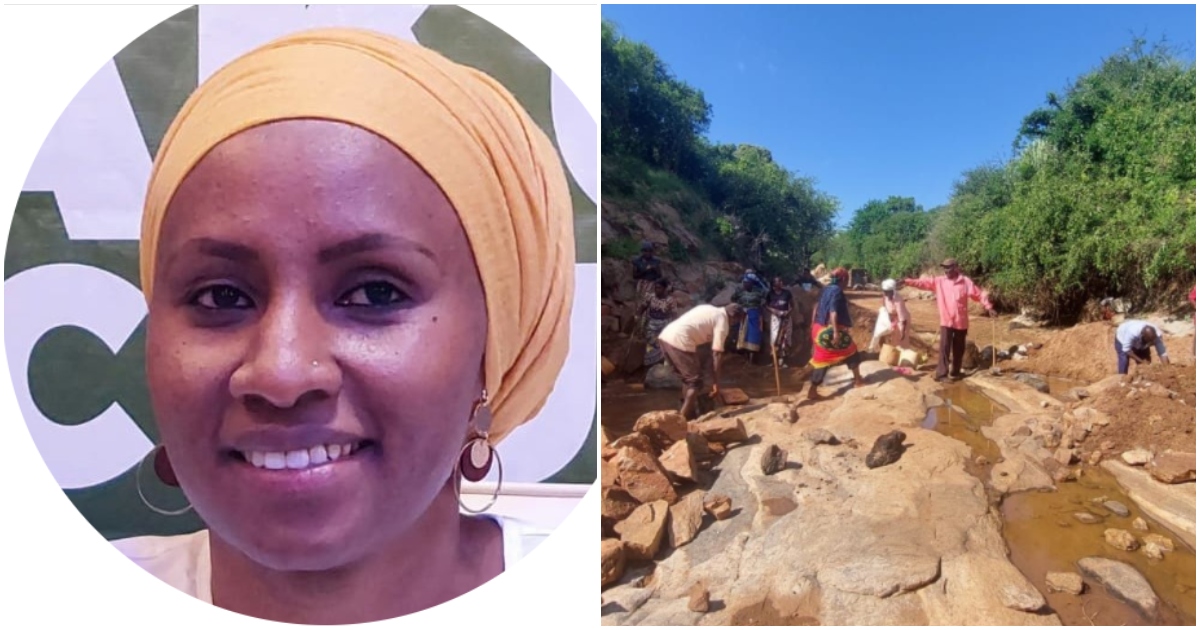Groundbreaking Workshop on AI and Technology-Facilitated Gender-Based Violence at AWiM24
Trending
Saturday May 24, 2025
Trending


Halinishi Yusuf rescues thirsty households in Kenya’s Makueni County.
Photo/Susan Mwenesi/AWiM
Nairobi
When Jonah Kyalo looks at what used to be River Kwekuyu, a sad feeling engulfs him, as it’s a far cry from what used to be a flourishing and bubbling river snaking its way through Makueni County.
The river has since turned into gaping dangerous canyons thanks to unscrupulous sand miners.
Speaking to African Women in Media (AWiM) in an interview, the Managing Director of the Makueni County Sand Conservation and Utilization Authority, Halinishi Yusuf reveals that cartels have always dominated sand harvesting in the area.
She said sand has always been an open-access resource, and this means that anyone could harvest it but in Makueni County it only benefitted dangerous cartels that include the high and mighty.
Became black market business
“Most of the sand harvested ended up in Nairobi and its environs; there was not much control of where it was being harvested and how much was being harvested,” said Ms Yusufe
In the absence of regulation and control, it became more of a sand black market marred with bribery, extortion and a lot of corruption.
Seasonal rivers were affected too by the haphazard sand harvesting. Sand, especially in seasonal rivers, acts to slow down water flow during rains and allows it to infiltrate and recharge underground storage. Much of it is stored in the sand.
“That’s how most of us get water in Ukambani, from under the sand. Without the sand, we will have hardly any water being retained in the dry river beds,’ said Ms Yusuf.
The seasoned environmental practitioner also disclosed that sand slows down evaporation since water is trapped within the sand grains and can be accessed through shallow wells.
Drying up of seasonal rivers causes households to lack water, and it is common knowledge that in Africa it is women and children who normally look for water.
Going for water over long distances is not only tedious but also time-wasting for them and that means that there is overall slow progress in development.
With water readily available, it also becomes easier for women to engage in small scale irrigation; guaranteeing household food security and a bit for agribusiness.
Enter Makueni County sand conservation, utilization act
Globally, the sand sector has been the most unregulated space; this is despite it being the most extracted natural resource after water.
In 2015, Makueni County moved to enact legislation that would regulate the sector and protect vulnerable groups like women while at the same time helping them get something out of it.
“There was a lot of resistance; in 2016 and 2017 vehicles belonging to the sand authority were burnt by sand cartels and officers got hurt,” said Ms Yusuf.
“There was a lot of fighting because people are resisting change. In a span of six years, we have moved from chaos to order,” said Yusuf.
Now, no sand goes out of the County and illegal sand harvesting has been contained,’ she added
It’s an open secret that climate change is here with us and its impacts have been merciless to Arid and Semi-Arid Lands (ASALs). In Kenya, the ASAL areas occupy over 80% of the country’s landmass. It is home to about 36% of the population, 70% of the national livestock and 90% of wildlife.
Makueni belongs in the above category and hence the need to conserve as much water as possible.
“For us, conserving sand is one of the ways of helping the common man build resilience and adaptation ways,” said the sustainable livelihoods projects coordinating, managing and implementing experts.
Sand conservation campaigns
Back to Mr Kyalo’s village of Ngondini, Kiima Kiu/Kalanzoni Ward in Kilome, the river has been recovered and the rural farming community has turned the recovered sections of the river bed into grazing fields.
The transformation, which is replicated in many other rivers and streams across the county, speaks of the successful sand conservation campaign by the Makueni Sand Conservation and Utilisation Authority.
“The Napier grass that we have used to rehabilitate sections of the damaged riverbed has outgrown. We are now grazing cattle and harvesting fodder where we used to scoop sand. In a way, our cattle now feed on the sand,” Mrs Kyalo revealed.
Building sand Dams
Along with recent improvements, the County of Makueni has also built six sand dams through a tripartite partnership that began in FY 2018/2019 in a bid to conserve more water.
A sand dam is a reinforced concrete masonry structure built across the riverbed of a seasonal river to increase sand recharge upstream and enlarge the natural storage capacity of the riverbed aquifer.
Water is stored in the pores of the sand reservoir that builds behind the dam, and the community members quickly get clean water by making shallow wells in the sand.
In total, there are about 700 sand dams built by various actors, including the national government, county government, development partners, community groups, and the private sector.
A good case in point of the effect of sand dams is the Kyanzonzo Sand dam in Kalawa Ward. Located at the periphery of the Machakos/Makueni County border, the 27 members of the Kyanzonzo unit group are delighted as they construct their first sand dam after decades of water shortage.
They attest to how sand dams have transformed their area during the long dry seasons.
“We used to fetch water from Thwake or Athi River on our backs,” the women narrated as they expressed how life was before they organised themselves into a group that constructed three sand dams in another river channel.
In Taa wa Kiuukuni Sand dam, Kako/waia Ward, a 30-member group is also constructing their first sand dam, located along Mukulu River that drains into Mbimbini River then into Thwake River.
They incorporated other community members who are not group members and are set to finish the construction works within a week.
Ukava wa Kithoni sand dam in Kathonzweni Ward located along the Wiindiiti River that drains to Ikaasu River then into Kikuu River and Upper Mbole Sand Dam in Nguu/Masumba Ward for Kinyou River that drains into Mbole River then into Muooni River are other dams that have been constructed by the locals.
Treated water
Michael Mutinda, a water treatment plant operator, from WOWASCO, the Water Company that draws water from the Kaiti river, treat it then distribute it to the residents of Wote town, the capital of the County has this to say, “We get our water from a water sump constructed under the sand. It measures about 400 cubic metres and that is where we infiltrate our water from that translates to 400,000 litres.”
A water sump is a concrete tank constructed underneath the sand and has infiltration pipes that allow water to seep into the tank then it is pumped out for supplies.
“We draw 800 cubic per day and the water supply is sufficient and the sand dam 100 metres from the sand is sufficient and we supply 700 or 800 cubic metres in a day,” he adds.
Sand and Sports
All work and no play is a saying the County seems to know so well as they have reserved some of the harvested sand for volleyball on the man-made sand beaches along the river.
So popular are the games at the sand beaches that Makueni County may host continental beach volleyball games ahead of the 2024 Olympic games.
“Talks are at an advanced stage for Makueni to host Zone 5 beach volleyball games which bring together 12 African countries,” the chairman of Kenya Volleyball Federation Makueni chapter, Mr Erastus Maingi said.
Mr Maingi was speaking during a recent Makueni leg of the National Beach Volleyball Tour which went down at Wote Town.
The games took place at an artificial beach set up at Unoa Primary School grounds. According to Ambrose Kisoi, the director of Sports in the Makueni County government, the plan was to play at courts set up at the section of River Kaiti which passes through Wote Town.
However, in consultation with FIVB, the international body which governs volleyball, the organisers changed the venue as the river was swollen.
In the clearest hint that KVF may consider the county for bigger games in future, KVF vice president Charles Nyaberi and Beach Volleyball Commission chairman Moses Mbuthia separately hailed Makueni County for being home to huge volumes of high-quality sand suitable for the games.
Upcoming beach volleyball stars tussled with elite players, among them Brackcides Agalla and Gaudensian Makhoha, the reigning African beach volleyball championships and the team Kenya took to the 2021 Olympics at Tokyo in Japan.
Makueni drew the attention of FIVB in 2019 when it hosted its inaugural beach volleyball games where 14 teams participated. All this is possible thanks to the efforts of one woman battling sand cartels.
This article is part of African Women in Media (AWiM)/UNEP Africa Environment Journalism Programme
Would you like to republish this story? Kindly contact janet@africanwomeninmedia.com
We’re not gonna spam. We’ll try at least.

Copyright 2020. African Women In Media
Copyright 2020. African Women In Media
Recent Comments